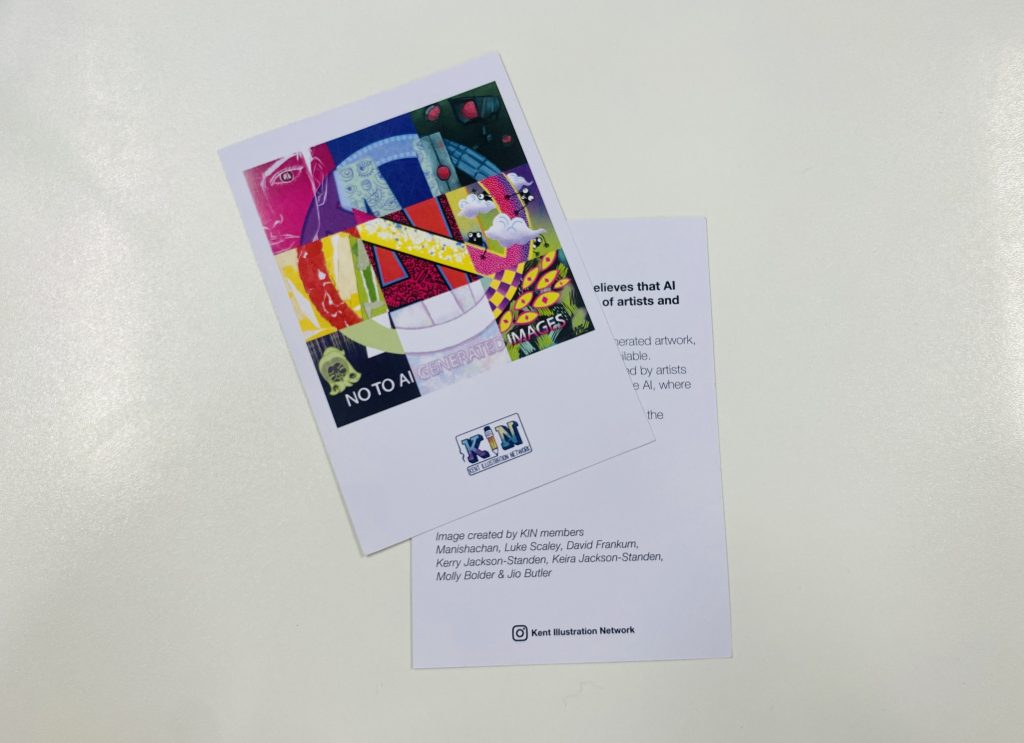Arthur Trombetta’s paintings exude a visceral and human quality. In one striking creation named Blood Vessel, thick clots of red paint are slashed with visible brushstrokes, resembling a heartbeat on a hospital monitor as they oscillate across the canvas. What might come as a surprise is that the 30-year-old French artist has been incorporating AI tools to enhance the pieces he produces in his studio in Rochester, Kent.
Trombetta, also known as ATTA, confesses that he uses tools like MidJourney and Dall E 2 to improve the quality of his work with size enhancement and correction, as well as upgrade and generate images from an original creation of his. These are the same generative AI tools which some artists see as a threat to their livelihood and existence because of how they plunder and repurpose copyrighted material. In Medway another local group of artists, the Kent Illustration Network, focuses on interactive comic project displays, art merchandising and t-shirt making, and has been pinning postcards branded with the slogan “No to AI-Generated Images”.
ATTA pointed out that in the era of rapid development of information technology, people are “becoming more and more connected”, and art has been very different from earlier. In the past, being discovered by a collector or exhibition marked one as “the next big artist.” Nowadays, the emphasis is on standing out amidst global competition and the rise of AI. Artists find themselves navigating specific business and marketing techniques, now considered “the rules of the game,” as they contend not only with their peers worldwide but also with the influence of AI.
“I understand why so many can be frightened by AI,” Trombetta says. “It’s like the invention of photography. It has allowed a major shift in the art, but does it come with bad consequences? Of course not.”
ATTA perceives AI as additional tools for artistic expression, providing opportunities to play, make, and create art. He believes this is just the beginning, making it challenging to predict the art movement it might eventually give rise to. ATTA suggests taking a cautious approach and observing how things unfold before making any excessive commitments.
But KIN stated: “We believe that Al art is jeopardising the value of artists and decreasing the quality of art by relying on sub-standard Al-generated artwork. Jobs that artists rely on will be unavailable. Al generators need the work produced by artists to make their images,” It added, “so if we only use Al, where will our art continue to come from? Most of the value of our art comes from the personal stories it tells.
“We want people to be aware of this issue, don’t let those stories die.”

As a response, ATTA said: “Every major shift, there will be a counter-movement, people will want something more real and more factual, that people still need to feel a physical connection with goods, especially with an art piece, NFTs were the hype not long ago yet it did not threaten physical arts, au contraire I think people realise that physical art is worth more than owning a link to a jpeg.
” I don’t think it’s more threatening than what kindle was for books, that’s why books are not dead yet and I don’t think painting nor photography will either, it’s just the approach we have towards them that might be different.”
ATTA believes AI could be a turning point in the history of art, or an opportunity to reinvent art. He does not use drones himself, but he has been studying how drones have changed the aesthetic of conflict expression through media and video games, influencing how he views his paintings.
“When you look from above, as if they were landscapes, “he said.
To this point, a lecturer in Art History from the University of Kent, who wishes to remain anonymous, said that from an academic perspective, noted that AI will not be a turning point in art history.
They said: “we can still apply existing theories of analysis and frameworks of discussion regarding skills, aesthetic value, social impact, ethical or other implications, authorship, originality, curation etc.”
ATTA also suggested that AI has subtly changed the public’s aesthetic, at least in traditional painting. He explained that as displays continue to be upgraded, people expect more artistic forms of bright colours and speculate that they might expect “more sophisticated work” as AI becomes more widely used.
The lecturer added to the view: “It’s not so much the aesthetic, but the values, cultures, messages and knowledge that artistic production captures and stimulates (i.e. of certain people, in a certain time and place).”
They described AI is having a “massive, negative impact” on people, as well as on perceptions and the world. As an educator, she worries about AI’s influence on art education and creativity, such as children’s creativity, imagination and skill development, and their influence through art (i.e. culture) learning, history… over art itself.
The debate extended beyond traditional painting to animation, 3D, and digital art. Essential for artists, AI generators enhance efficiency in the creative process, particularly in swiftly generating ideas, prototypes, or multiple iterations.
ATTA shared his experience happily, said: “it seems that we have reached a plateau regarding 2D images generators – there is no more huge evolution outside the improvement of the quality of the images generated, where I find AI generators to be impressive now is with moving images and videos.
“You can generate a whole Pixar inspired movie now if you want!”
Digital design specialist Matthew Beeching, Kent, noted that digital tools have replaced traditional animation. Even renowned studios like Ghibli have used digital tools since the 80s to speed up the process and experiment with procedural 3D animation.
He said: “Disney too have used methods of generating in-betweens for at least a decade, tools like these will continue to be taken on-board to speed up slow and usually tedious work. It’s a fairly volatile industry that has seen a lot of roles change, processes adapt, and requirements altered.”
Additionally, he believes AI cannot replace digital artists or designers. He explained that AI is a “conceptual” tool that can evolve existing tools, improve others, and even enhance VR applications to help them transcend hardware limitations. But he said: “As an artist I have no enthusiasm in cutting out the ‘fun’ part and using another artist’s work as my own, but it stands art generators pose a ‘large ethical issue’ that should ‘discourage anyone from using them’ for anything. But it stands art generators pose a ‘large ethical issue’ that should ‘discourage anyone from using them’ for anything other than reference material. Other than reference material.”
Blaine Epsley, a Digital Arts and Technology lecturer from university of Kent, held the same view. He pointed out that even though AI can definitely help productivity, all the tools (like the Luma AI — a 3D model AI generator, and Deep Motion — a 3D animation AI generator) will always be “human controlled interactions”, and AI toolsets alone cannot achieve today’s expected standards.

He said: “Even when this inevitably improves and AI catches up with the objective technical quality of work, the difference between creating something that is simply technically well-done vs something that is supposed to invoke human feelings and emotion is something that is not possible without free thinking human interaction.
“Human feelings and emotion are something that is not possible without free thinking human interaction.”
While Matthew thought it is too early to determine where AI will go in its current form, given the complexity, Blaine said it will be a turning point in the history of technology, but not art history.
Blaine speculated that AI will in the future be referred to as “AI tools” in the same way that “smartphones” and ” smart TVs” have evolved into “phones” and “TVs”, but that art is a kind of expression, creation and imagination that AI cannot accomplish.
It is worth noting here that copyright laws vary widely from country to country around the world. Unlike in the UK, for instance, the US and the EU only works with “human authors” are copyrighted.
Meanwhile, Matthew mentioned that for animation and digital art, AI has altered the public’s perception of artists’ work and styling because of the fact that many people are already comparing AI work to artist’s work. Matthew described ‘AI style’: “AI Art relies on the stylings of existing imagery consistently skewering proportions, adding additional appendages and undesirable artefacts.”
However, Blaine emphasised: “The visual aesthetic of digital artwork will always be controlled and judged by human interaction, the artists themselves, regardless of the tools they are using.”
He implied that even if AI frightens many people, AI tools will not negatively affect jobs in the visual effects and animation industry. Depending on how artists use AI tools, it will even create more opportunities and positive support. This is a fact that any advanced or intermediate artist in the specialisation would agree on. Thus, as an educator, he suggested that starting with education, teach students to use AI correctly and responsibly so that they can make informed, considered decisions. This is what many artists are trying to do, such as offering free AI training to the public.
Generally, it is evident that AI has yet to fully replace human artists in any form of art but became a valuable tool to boost efficiency.
At the same time, ATTA added excitedly: “AI generators are enjoyable tools for artists, aiding in refining pieces without mastering new skills, that they assist in building sketches and concepts, shaping my creative process, and personally, I don’t see the appeal in crafting an entire art piece from start to finish.
“The more AI generated art will flood the world; the more people will seek personal commission from artists in order to find that imperfect human touch and also uniqueness and tailor-made work, and I can’t wait to give it a go to try other fantastic AI generators!”

